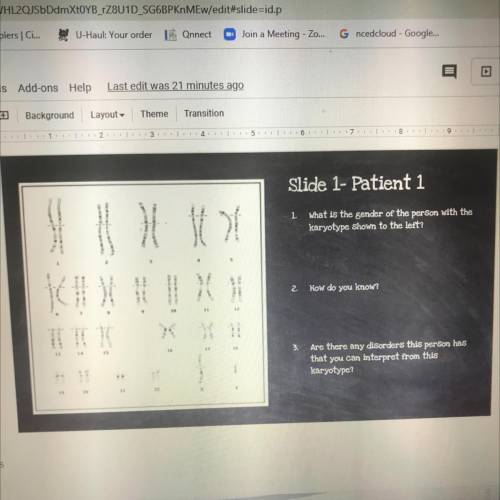Slide 1- Patient 1
1
What is the gender of the person with the
karyotype shown to the l...

Biology, 16.11.2020 18:10 thomelfin529
Slide 1- Patient 1
1
What is the gender of the person with the
karyotype shown to the left?
2
How do you know?
3.
Are there any disorders this person has
that you can interpret from this
karyotype?


Answers: 3


Another question on Biology

Biology, 21.06.2019 17:00
What is produced during the krebs cycle? co2, atp, nadh, and fadh2 pyruvate, co2, and atp atp, fadh2, and h2o h2o, adp, and nadh
Answers: 1

Biology, 21.06.2019 20:00
Read the following scenario to answer the following question. over the past 60 years, many amphibian species have experienced significant population declines, and some species have become extinct. scientists suspected that local human activities such as the destruction of wetlands, regional pollution, and deforestation were the main reasons for these losses. however, research over the past 20 years reveals significant amphibian population declines in protected areas of the world, such as nature preserves and parks. these global declines suggest widespread problems including increased ultraviolet radiation, acid rain, and disease. in switzerland, for example, 14 of the 20 native amphibian species are threatened with extinction. when most populations of a wide-ranging amphibian species are lost and the few remaining populations are widely separated, we expect to see that a. the founder effect becomes increasingly important b. microevolution no longer occurs c. gene flow between populations is reduced d. artificial selection becomes a greater factor in microevolution
Answers: 2

Biology, 22.06.2019 02:00
The accompanying figure shows the percent of selected dna sequences that match between a chimpanzee and other primates. these data support the hypothesis that the figure shows the percentage of selected d n a sequences that match between the chimpanzee and other primates. the human has an almost 98 percent match, the gorilla has an almost 97 percent match, the orangutan has a 96 percent match, the gibbon has an almost 95 percent match, and the old world monkey has an almost 92 percent match. the accompanying figure shows the percent of selected dna sequences that match between a chimpanzee and other primates. these data support the hypothesis that the figure shows the percentage of selected d n a sequences that match between the chimpanzee and other primates. the human has an almost 98 percent match, the gorilla has an almost 97 percent match, the orangutan has a 96 percent match, the gibbon has an almost 95 percent match, and the old world monkey has an almost 92 percent match. chimpanzees and gibbons are the most closely related the chimpanzee's closest surviving relative is humans orangutans are the primates least closely related to chimpanzees old world monkeys and gibbons are the most closely related
Answers: 1

Biology, 22.06.2019 03:30
Multicellular organisms use cell division, mitosis, for growth and the maintenance and repair of cells and tissues. single-celled organisms may use cell division as their method of reproduction. regardless of the reason for mitosis, the process ensures genetic continuity. what is the step in the cell cycle that ensure genetic continuity?
Answers: 3
You know the right answer?
Questions

Mathematics, 23.10.2020 06:01




Law, 23.10.2020 06:01

Geography, 23.10.2020 06:01


Advanced Placement (AP), 23.10.2020 06:01

History, 23.10.2020 06:01


Mathematics, 23.10.2020 06:01



Mathematics, 23.10.2020 06:01

Mathematics, 23.10.2020 06:01

Mathematics, 23.10.2020 06:01






